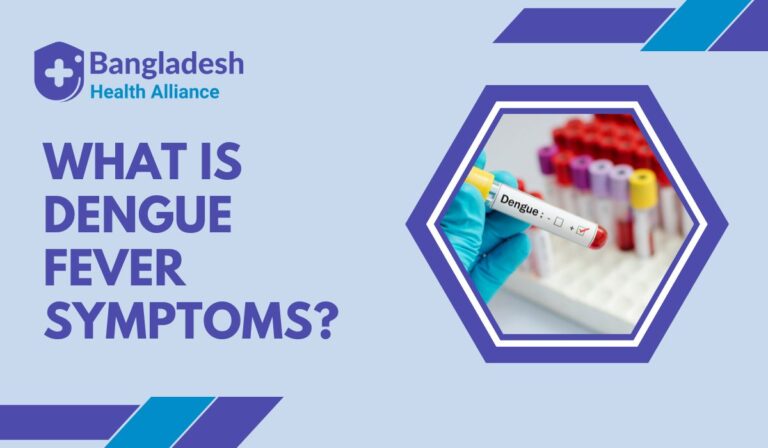Dengue fever, a prevailing mosquito-borne viral illness, has established itself as a significant health concern in numerous tropical and subtropical regions, including Bangladesh. In this informative guide presented by the Bangladesh Health Alliance, we delve into the intricate realm of dengue fever symptoms, equipping you with the knowledge needed to recognize, understand, and respond to this ailment, all backed by scientific references.
What is Dengue Fever Symptoms? The Early Indicators: Recognizing Dengue Fever Symptoms
Dengue fever often begins with a sudden onset, akin to an unwelcome guest arriving unannounced. The symptoms manifest in distinct phases, each characterized by its unique traits. Here’s a comprehensive overview of these phases and the symptoms they entail:
-
Febrile Phase:
- High Fever: A sudden and sharp rise in body temperature, often reaching 104°F (40°C) or higher, is a hallmark of dengue fever.
- Severe Headache: Intense and persistent headaches, sometimes described as a “dengue headache,” are a common complaint.
- Muscle and Joint Pain: Severe pain in muscles and joints, often referred to as “breakbone fever,” can cause discomfort.
- Fatigue: Profound tiredness and weakness often accompany dengue fever, leading to reduced energy levels.
- Pain Behind the Eyes: Pain or discomfort behind the eyes, known as retro-orbital pain, can be a distinctive symptom.
-
Critical Phase:
- Bleeding: In some cases, dengue fever can progress to dengue hemorrhagic fever (DHF), marked by bleeding under the skin, nosebleeds, or bleeding gums.
- Organ Impairment: DHF can lead to liver or heart problems, causing abdominal pain, vomiting, and difficulty breathing.
- Fluid Accumulation: Dengue shock syndrome (DSS) may occur, causing severe fluid buildup, shock, and a rapid drop in blood pressure.
-
Recovery Phase:
- Resolution of Fever: The fever subsides, and overall symptoms gradually improve.
- Lingering Fatigue: Weakness and fatigue can persist for weeks after the fever subsides.
Distinguishing Dengue Fever from Other Illnesses
Dengue fever symptoms often mimic those of other viral illnesses like the flu or chikungunya. However, a distinguishing factor is the presence of joint pain and the sudden onset of high fever. Proper diagnosis is crucial, as untreated severe dengue can be life-threatening.
Seeking Medical Attention
If you or someone you know experiences symptoms that align with dengue fever, particularly high fever, severe headache, joint pain, and muscle pain, it’s essential to seek medical attention promptly. Early diagnosis and medical intervention can significantly reduce the risk of complications.
Preventive Measures
Prevention is paramount when it comes to dengue fever. As there is no specific antiviral treatment for dengue, focusing on mosquito control and personal protection is vital:
- Eliminate Breeding Sites: Get rid of stagnant water in and around your living environment to prevent mosquito breeding.
- Mosquito Nets and Repellents: Use bed nets and apply mosquito repellents to reduce the risk of mosquito bites.
- Protective Clothing: Wear long-sleeved shirts, long pants, and socks to minimize exposed skin.
- Community Awareness: Educate your community about dengue prevention and collaborate to control mosquito populations.
Learn From Video – What is Dengue Fever Symptoms?
যে সব লক্ষণে বুঝবেন ডেঙ্গু হয়েছে | Dengue Symptoms By Channel 24
In conclusion, recognizing dengue fever symptoms is crucial for timely intervention and effective management. By understanding the phases and manifestations of this ailment, you can take proactive steps to protect your health and the well-being of your community.
References:
- World Health Organization. (2021). Dengue and severe dengue. Link
- Centers for Disease Control and Prevention. (2021). Dengue. Link
- Ministry of Health and Family Welfare, Government of Bangladesh. (2021). National Guideline on Dengue Fever and Dengue Hemorrhagic Fever. Link
- Dengue Symptoms. (2021). Link


